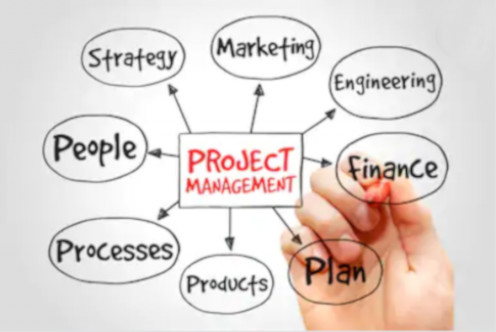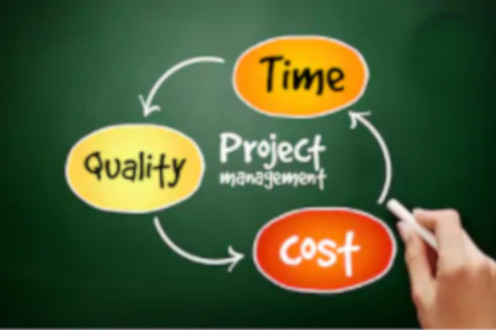The Project Manager's Role: A Closer Look

What does it mean to have the title of project manager? "Project manager" is often used loosely to describe any person in any work environment who manages any type of project from beginning to end. But in a larger sense, the actual title of project manager is reserved for those whose primary responsibility is managing the phases of work required to accomplish one or more of an organization's stated project objectives.
As a career field, project management is gaining more attention and prominence in organizations as advances in technology continue to enable the successful seizing and managing of global business opportunities.
The primary responsibilities of the project manager include creating a clear, focused plan for managing a project, crystallizing and specifying project objectives, determining and stating big and small project requirements, and then managing a project's scope by ensuring that cost and time constraints are used in a way that will produce the quality of results that are needed to meet project objectives.

I am a communications professional who has, over the past 25 years, managed hundreds of projects involving writing, graphic design, publishing, marketing communications, and creative writing. And, even though I've managed many, many projects, I've only held one job where my title included both "project" and "manager."
Several years ago I took and passed, over a two-week period, all twenty-three hours of project management education required by the Project Management Institute (PMI). At the time, I was being prepared to sit for the Certified Associate in Project Management (CAPM) test, PMI's entry-level certification. This certification is designed for people who need to know the fundamentals of effective project management--including terminology and processes. Even though I ultimately decided not to pursue the certification (and I probably never will), I now know enough about the field of project management to explain, in detail, a project manager's responsibilities.

Four Key Components of Project Management
Project management consists of four key-component areas of responsibility, and these are:
- Project Scope
- Project Resources
- Project Schedule
- Project Costs
To successfully complete a project, the project manager must manage each component well and simultaneously. Effective management hinges on the project manager's ability to understand the relationship (or interrelatedness) that exists between and among these four components. It is critical that the project manager not only understands how to manage, together, all components, but he/she must also be able to communicate this understanding to stakeholders and members of the project team.
The project manager must identify primary stakeholders (client/customer to receive end results; project sponsor; those who will use what the project produces, and the project's team members), and he/she must be prepared to communicate regularly with key project team members. Understanding the roles and responsibilities of each member of the project team, while effectively supporting and motivating them, is key to good project management. The project manager must be certain that team members own their roles, and that each person works hard, contributing to the project while utilizing the best of their abilities.
Project Scope Statement
The scope of the project has to do with what the project is designed to accomplish (project objective/desired results), and what amount of time and money is to be allocated in order to achieve the desired end results. In developing a project plan, the project manager should create a scope statement that clearly states/identifies:
Background/rationale for project--The project manager must know and be able to explain why the project is needed. What problem/concern does the business have that this project is designed to address? Are there other areas of business operation, or other business activities, that will be affected by this project? If so, the project manager should make sure these are described in the project scope statement.
Objective--What are the project's deliverables, that is, the desired end results of the project? The project manager must work with those requesting the project to come to an agreement about what are the acceptable end results of the project. What will the project produce, and what criteria and/or process will be used to evaluate when acceptable results have been produced?

Restrictions--What are the constraints of the project? The project manager must clearly state the limitations of the project. What are the project's time constraints? What are the project's financial constraints? Anything affecting what can be achieved, with restrictions regarding time and cost, must be understood and agreed upon. By placing restricting elements in the statement of scope, the project manager and the project requester create a binding agreement that provides clarity for all, prior to starting work on the project.
Assumptions--What assumptions are being made that, if they turn out to be invalid, could affect the end results of the project? The project manager must think about what circumstances/situations now exist that could affect project outcome, that he/she is expecting to continue to exist throughout the project's duration. Risks need to be evaluated and considered as part of a project's planning and management processes.
Project managers must communicate to all stakeholders the importance of input into the project scope statement. Any change in one restriction must be met by an appropriate change in another, and, for this reason, it is usually unwise to change components of the project scope once a project is underway, unless any and all needed changes are made.

Project Resources
The project manager is responsible for managing, well, all of the resources needed to achieve project objectives, including people/human resources, equipment, and material. Once the project scope and a timeline for completing the project is agreed upon, the work of the project manager can finally get underway. It is now time for the project manager to effectively manage allocated resources, utilizing them in a way that will produce the desired end results.
The project's human resources
The project manager must understand the human resource needs of the project. What skill sets are needed? How many people are needed to carry out specific responsibilities? What amount of time will each individual need to devote to the project on a daily, weekly, and/or monthly basis? The project management plan should include a plan for managing the project's human resources. It should, if possible, include the name and responsibilities/job description of every individual needed to work on the project who is assigned a leadership role in completing it. It is the project manager's responsibility to make sure that people understand, accept, and carry out to the best of their ability, their project roles and responsibilities.
The project manager manages the work of key employees (i.e. the senior person in each group), vendors, and subcontractors, even though company employees will usually also report to a line manager/supervisor, who might not be part of the project team. Still, it is the responsibility of the project manager to provide needed direction/guidance/supervision to employees when it comes to their participation/contributions as part of the project team.
The project manager is also responsible for helping to put together effective project teams. When selecting the right people to work toward a common goal, in addition to knowledge, talent, and technical skills, the project manager should consider individuals' personalities. Knowledge of personal strengths and weaknesses, as well as dominant character traits of key team members. can help project managers assemble and motivate people capable of working well and productively together, as members of a team.

The project's equipment resources
It is the project manager's responsibility to make sure that the proper equipment needed to achieve project objectives is available and in place, when and where it is needed. The nature of the project will determine/dictate equipment needs, and these needs, most likely, will necessarily change from project to project.
It is the project manager's job to make sure that a detailed plan for having the proper equipment is available and that any equipment provided is operational (including supplies required for equipment operation), when/where it is needed. To properly manage equipment needs, an equipment management plan should be part of the overall project plan.
The project's material resources
Since materials will be used before, during, and in completing any project, project managers are responsible for making sure any needed materials are purchased. While working with those who understand what materials will be needed, the project manager should be certain that needed/required materials are supplied when and where they are needed, in the proper amounts. Doing so will help to avoid any problems that might be encountered concerning materials storage/deterioration.
Materials can be a major expense, and, for this reason, proper management can make a big difference in the bottom line results of any project. For this reason, a materials management plan should be part of the overall project plan.

Project Schedule
Time management
Perhaps the most critical component of the project manager's responsibility is the management of the project's time/schedule. Failure to manage this all-encompassing aspect of a project will lead to disastrous results that will not deliver the desired end results within the allotted time frame. Time constraints are a vital part of the project's scope statement, and, therefore, failure to work with the limitations of time schedules will exert great impact on other key components of the project manager's responsibilities. For example, not adhering to scheduled time constraints is the most commonly cited reason, by project managers, for losing control of a project's budgetary constraints.
The Critical Path: Project managers are responsible for managing the project's "critical path." The critical path includes the tasks and activities that, overall, will determine project duration.
When planning the management of tasks/activities, some will have "float." That means the task/activity has flexibility in terms of date/time required to begin or to complete it. If there is "zero float," then there is no flexibility. The project's critical path, therefore, is a line drawn through all the tasks with zero float. All tasks that are on the critical path must be completed on time in order for the project to be completed on time.
Viewing a project as a whole consisting of the elements of tasks/activities, schedules, and a critical path, can help tremendously in managing project time allotments. The project manager is responsible for determining the required or necessary time and resource allocations needed for successful completion. He/she is also responsible for taking into considering the interrelatedness of tasks to be performed in order to achieve project objectives. Dependencies, overlaps, and sequencing of tasks must be factored into scheduling time allotments based on the project's critical path.
The project manager must understand that part of managing time is realizing that a project's plans may need to be changed as situations/circumstances change, and that a task can be taken from the critical path (or added to it) based on the adding or the subtracting of key project plan components. For example, the adding of extra human resources to complete a task can cause the task to be completed earlier than planned, and taken off the critical path.
Scheduling problems are also responsibilities that must be handled or negotiated by the project manager. If, after the project begins, it becomes clear that the estimated time of delivery of end results is unrealistic, then one of three things must happen:
- A new time of delivery must be negotiated, delaying delivery of anticipated end results.
- More resources must be added (adding to costs) in order to deliver anticipated results by the original deadline.
- Project deliverables, the originally anticipated end results, must be changed.
Thankfully, there is computer software available to help project managers develop and adhere to a plan for managing tasks that answer key questions. What is to be the duration of each task? Which tasks must be completed prior to the starting other tasks? Which tasks can be performed simultaneously? Will required amounts of resources be available to sustain the completion of several tasks undertaken at the same time, and for the same duration? Which tasks have flexibility in the date/time required to begin and/or finish them?

Project Costs
It is the project manager's responsibility to keep a project's actual costs equal with or less than estimated costs, in order to keep the project within budget, thereby maximizing profit potential for the client. Project budgets are created for a good reason--having a budget helps the company requesting the project's end results to manage its expenses, and its profitability. It is, therefore, the responsibility of the project manager to pay close attention to critical costs (the 20% of cost items/tasks that are using 80% of the resources), throughout the duration of the project, so that it can be completed within budget.
It is not possible to create an "exact" budget, because many of the costs that make up the original budget will be estimates, not actual costs. The estimated cost of some items will be more accurate than the estimated cost of other items. For example, it might be easy to estimate, accurately, the cost of employee labor, but it might be much harder to predict the cost of the rental of certain specialized, high-ticket equipment if there is no way to estimate how long it will be needed.
In addition to the uncertainty of some expenses, costs can also be affected by events such as delays caused by weather conditions, or by problems getting needed supplies delivered on time. Although budget "contingencies" are usually developed to make allowances for actual costs that are markedly different from estimates, clients are happiest when project managers use as little of the "contingency budget" as possible.
Beware of Project "Scope Creep"
Many times, after a project is underway, the client/person requesting the end results, will ask that a small change be made, here and there, in some aspect of the original project plans. As these requests for changes add up, they become what is known as "scope creep." The project manager is responsible for managing the project scope--and that means managing project resources, time and money. While the adding of one or few small changes might be manageable, a lot of small changes can affect, substantially, the manager's ability to deliver anticipated end results by the original deadline.
To manage "scope creep," it is the project manager's responsibility to make sure that any requested changes, large or small, be approved along with a matching and appropriate change in the project budget and/or the schedule for delivery of end results.
Article Author's Note on Project Management Software.
There are many different brands and types of software applications designed for helping project managers manage projects, tasks, and teams. Some of these, believe it or not, are actually free to use. Click here to see a description of Top 10 Open Source Web-Based Project Management Software.
© 2012 Sallie B Middlebrook PhD








